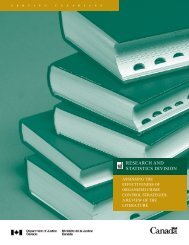National Threat Assessment 2008. Organised Crime - Politie
National Threat Assessment 2008. Organised Crime - Politie
National Threat Assessment 2008. Organised Crime - Politie
You also want an ePaper? Increase the reach of your titles
YUMPU automatically turns print PDFs into web optimized ePapers that Google loves.
conclusion has to be that there are serious consequences due to the physical<br />
and psychological harm suffered by victims. It is difficult, however, to determine<br />
the number and size of these networks, and the involvement of Dutch nationals.<br />
Moreover, the assumed group dynamics of these networks and the effect on<br />
the (indirect) form of collaboration between its members require further<br />
investigation. This is why the qualification of blank spot has been given to the<br />
non-commercial production and distribution of images of child abuse online.<br />
2.10 Producing and distributing counterfeit money 36<br />
2.10.1 Introduction and scope<br />
The counterfeiting or falsifying of money as such is not a criminal offence.<br />
It only becomes a criminal offence if people intend to spend the money (or cause<br />
it to be spent) as if it were real and not counterfeit (sections 208 and 209 of the<br />
Penal Code). Money is counterfeit when coins or notes are copied in full.<br />
Money is falsified when a real note (or a real coin) is modified (by changing the<br />
denomination, for example). Falsified money will not be discussed in this section.<br />
The focus here is on the production and distribution of counterfeit money, which<br />
means the forgery of money and/or the deliberate distribution and spending<br />
of counterfeit money as if it were real and not counterfeit.<br />
2.10.2 General context<br />
In early 2007 a preliminary study was conducted on counterfeit money.<br />
This preliminary study was supposed to show whether further research into<br />
this subject was required in order to establish a qualification as part of the NTA.<br />
The conclusion was that further research was not required. In the previous<br />
NTA (2004) the presence of counterfeit money was not included as a threat<br />
due to its limited scale, and since then the scale had only decreased. In the<br />
meantime, however, it has become clear just at the last moment that the<br />
decrease in the number of counterfeit euro notes has not continued; since<br />
early 2007 there has even been a significant increase. This is sufficient reason<br />
to discuss the development of the scale of the activities here in more detail.<br />
36<br />
This section is based on an internal document on this subject that was drawn up for the<br />
NTA 2008 preliminary study; no separate substudy was carried out on this subject (see Chapter<br />
1). The author of this document is F. Nieuwenhuis of the Department of International Police<br />
Information (Dienst IPOL). In addition, the IPOL document entitled Overzichtsrapportage vals<br />
geld 2007 by M. Naber was used.<br />
chapter 2 – Illegal markets<br />
91








